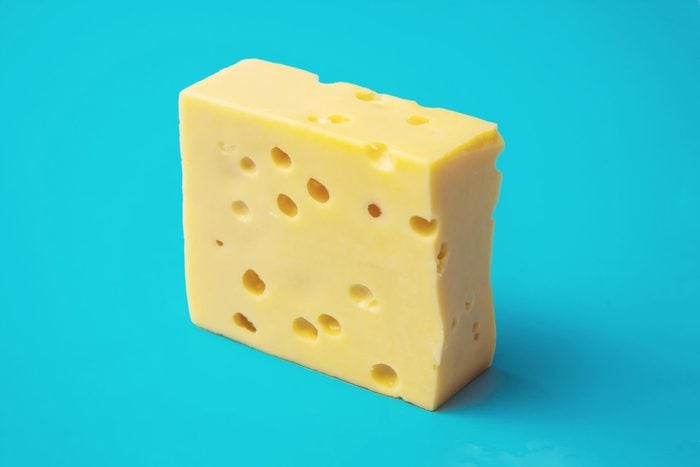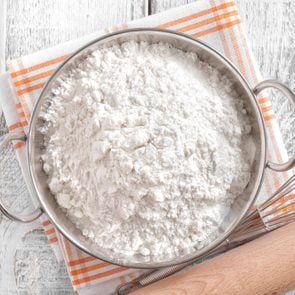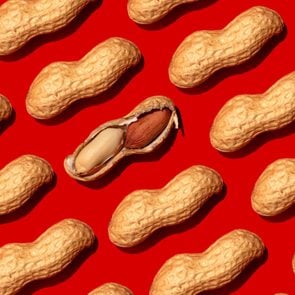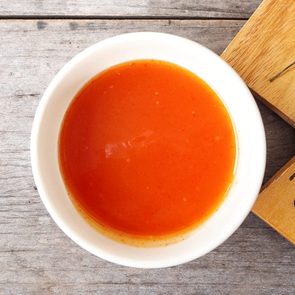Why Does Swiss Cheese Have Holes in It?
Updated: Mar. 20, 2024

We asked a cheese scientist to explain what gives Swiss cheese its characteristic holes
Cheese is probably one of the most beloved foods in the nation. If you’re not getting healthy with a bowl of cottage cheese, you’re slapping American cheese between slices of bread and grilling up a hot and gooey classic. With its mild, versatile flavor, Swiss cheese is right up there with everyone’s favorites. The fun holes don’t hurt, though we have to wonder: Why does Swiss cheese have holes at all?
To get to the bottom of a question that’s had us scratching our heads from breakfast to dinner, we spoke to a cheese expert. Read on to get all the fascinating food facts, including whether Swiss cheese is really from Switzerland and if it exists sans holes.
Get Reader’s Digest’s Read Up newsletter for more food, humor, cleaning, travel, tech and fun facts all week long.
What is Swiss cheese?
“Swiss cheese is always described as the cheese with holes,” says Mark Johnson, PhD, a distinguished scientist at the Center for Dairy Research at the University of Wisconsin. “It has a firm body and has a nutty but sweet flavor. It is also very low in salt compared to other cheeses.”
Given its name, the cheese’s origin shouldn’t be too tough to guess. Known as Emmenthal cheese, it’s thought to have been made for the first time in Switzerland (specifically in the Alps) in the 14th century. “It was a hard cheese that had a long shelf life and that could easily be transported down the mountains where it was made,” adds Johnson.
Today, however, the term Swiss cheese refers not to where the cheese comes from but to the type of cheese. In other words, it all comes down to how the cheese is produced. “Most Swiss in the U.S. is made in Ohio. The largest produce is Brewster Cheese in Ohio,” Johnson says. “But other states also have Swiss cheese plants, including Wisconsin, Iowa, Utah and perhaps others.”
So while its origins trace back to Switzerland, the Swiss cheese in your fridge was made in the good ol’ U S of A.
What is Swiss cheese good for?
The flavor and texture of Swiss cheese make it ideal for piling on sandwiches, melting on top of soup or a hamburger, mixing into a quiche or adding to a whole bunch of other recipes.
Here are some of our favorite uses for Swiss cheese:
- Cuban sandwich
- Reuben sandwich
- French onion soup
- Mushroom and Swiss burger
- Ham and Swiss omelet
- Muffuletta
- Chicken cordon bleu
- Philly cheesesteak
- Cheese fondue
- Macaroni and cheese
Wash it all down with a rich, malty beer or crisp white wine—both pair well with Swiss cheese’s flavor.
Why does Swiss cheese have holes?
Everyone knows Swiss cheese is the holey-est cheese, but few shoppers know what makes this type of cheese so different from the rest. So we asked the expert: Why does Swiss cheese have holes?
It comes down to how it’s made—specifically, the bacteria that is used in the production of Swiss cheese. “Cheesemakers add a special bacteria called Propionibacterium shermanii. This bacteria ferments lactic acid and produces carbon dioxide,” explains Johnson. “Carbon dioxide collects in certain spots in the cheese and produces a large bubble, or eye. No other cheese uses this culture.”
Keep in mind that in grocery stores today, you’ll see different kinds of Swiss cheese, all of which share this signature characteristic. “There are other versions of Swiss, such as baby Swiss, Maasdam, Jarlsberg and Emmentaler, that are made with Propionibacterium, so they also have eyes,” he adds.
This bacteria is what sets Swiss cheese apart from your other dairy favorites. From burrata to cheddar to squeaky cheese curds, other cheeses lack the Propionibacterium that would give them holes.
Can you buy Swiss cheese without holes?
Nope, nor should you want to. “Swiss cheese without eyes is called ‘blind Swiss,’ but that is considered a defect,” says Johnson. If you see a cheese labeled Swiss that doesn’t have holes, it’s not true Swiss cheese—and it won’t have the taste or texture that you’re looking for.
So next time your dining companions ask, “Why does Swiss cheese have holes?” you can confidently say it’s all about bacteria. And speaking of your diary choices, learn about the sneaky ingredient found in shredded cheese before your next trip to the supermarket.
About the expert
- Mark Johnson, PhD, is a distinguished scientist and the assistant director of the Center for Dairy Research in the College of Agricultural and Life Sciences at the University of Wisconsin, where he has worked for more than 30 years. His expertise lies in the development, manufacturing and ripening protocols for unique cheeses.
Source:
- Dairy Farmers of Wisconsin: “The Cheese Lover’s Guide to Swiss Cheese”



